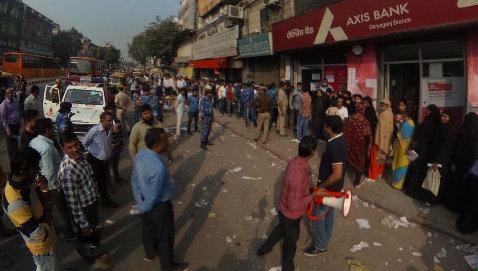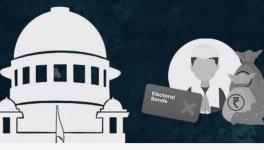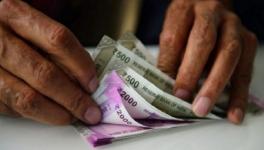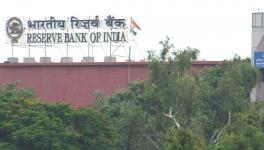Demonetisation: Unfolding Disaster for the People

Citizens facing hardship due to demonetisation.
The impact of the so-called demonetisation measure of the BJP government is proving to be much grimmer than even we, the critics, had anticipated. The economy is slowly grinding too a halt, with the poor and daily wage earners being particularly badly hit. Already, Arun Jaitley, the Finance Minister is talking about two to three weeks before things return to normal, while the Prime Minister has asked for a 50-day grace period before judging him.
What makes the situation even more galling is the sheer callousness that the FM and the PM are displaying. Jaitley talked about some temporary pain and using credit cards instead of cash. This in an economy where the bulk of the people do not have credit cards or mobile banking. Modi went even further, claiming that after this measure, “...the poor are enjoying sound sleep, while the rich are running from pillar to post to buy sleeping pills”. This, when 25 people have died in queues in just 6 days, there have been instances of suicide for lack of cash, and people are not able to pay for hospitals and ambulances. The Modi government seem to believe that they can create their own “reality” by repeating the big lie loudly, and enough number of times.
Prabhat Patnaik and a host of others have talked about the stupidity of these measures, which seeks to focus on the flow of black money, while black money is actually unaccounted or black wealth. This black wealth is stashed in dollar accounts abroad, or in land, gold, jewellery, etc. Demonetisation has very little impact on this black wealth. Govind Acharya, the former RSS ideologue has estimated that even by most optimistic account, demonetisation of the existing Rs. 500 and Rs. 1,000 notes will interdict only 3% of this black wealth.
Let us – for arguments sake – leave out whether these measures will help control black money. Let us look instead at what is happening in the economy to see the magnitude of the disaster that is now unfolding. Simply put, the government has suddenly withdrawn 86% of the cash in circulation from the economy. The Rs. 500 and Rs. 1,000 notes represent 86% of the value of all the cash in the economy. As each note is used multiple times, if I buy something from A, who then buys something else from C, and so on, the impact of this withdrawal of notes leads to a cascading one in the economy, stopping a whole series of transactions. Unless this cash can be put back in the economy quickly, the wheels of the economy will slowly come to a halt. This what we are witnessing right now.
Initially, we thought that the government would be able to put back this cash relatively quickly using the banks and the ATM's. This has not happened. The notes printed were of different sizes than the existing Rs. 500 and Rs. 1,000 notes so ATM's have to be manually recalibrated. This is going to take time. And there are 2 lakh ATM's in the country. This is not the only failure. The banks are regularly running out of cash. Even in the capital city of Delhi. There are about 52,000 rural branches of banks in the country for more than 5 lakh villages or about 1 branch to 12 villages – and they are just not enough to handle the magnitude of the work they now have to handle.
Knowing that the banks were not going to be able to handle the enormity of the task that they were being entrusted, no emergency measures were put in place. Simply put, the government has screwed up big time, not only on the idea of demonetisation, but also its execution. It had a Plan A, which has failed and failed miserably. And it has no Plan B. Instead, it is simply lying to the people about how this is a temporary pain for getting rid of black money.
Without money in the banks and the ATM's, the circulation of money has slowed to a trickle. The poor have been the hardest hit. They survive on daily wages and are a part of the cash economy. They are not receiving cash as most employers of casual labour do not have the cash to pay them. Whatever little they had, are now mostly worthless, unless they stand for hours in long queues, which also mean loss of their daily wages. While shop keepers are providing temporary credit, they themselves are running out of stock. Without inflow of money from their customers, they are unable to replenish their stock. The entire cash and credit economy on which India's retail trade functions, has simply collapsed.
At least in the urban areas, there is a trickle of cash from the banks. The story in the rural areas and far flung villages is far worse. There is simply too little or no cash. People walk 10 to 20 kilometres to banks and go back empty handed. And Mr. Modi thinks they are sleeping peacefully at night; without money even to buy food for their children.
This is only one part of the story. The agriculture is taking a big hit this year, as there are standing crops ready to be cut, but no buyers. If the traders agree to buy, it is well below market price and even then, with old, demonetised notes. And without selling their crops, farmers cannot buy seeds, fertilisers, etc. Agriculture, which was looking up due to a good monsoon, is now going to suffer due to this entirely man made disaster.
Meanwhile, trucks transporting goods are coming to a halt. Again, a trucker requires cash to pay for food, toll, octroi and plain and simple bribes, as they drive from one city to another. Neither the companies nor the truckers have the cash to keep their fleet running. Without trucks, we are soon going to see shortages develop.
Things in the industry are no better. The bulk of India's workforce in the industry is concentrated in construction and textiles. Most of them pay their workers weekly, and in cash. With a ceiling of Rs. 50,000 per week, they also will not be able to meet their payroll, leading to either retrenchment or temporary closures.
If this god-awful mess that Jaitley and co. have created, eases up in a month or two, it will have still struck a heavy blow to the economy. This is a huge, contractionary measure and it will have consequences for the economy far beyond the one or two months of dislocations.
Though India has brought down the total number of people below the poverty line, the bulk of India's population is not middle class, but what the World Bank calls “vulnerable”. They have incomes between $2 to $10 per day, and with a single catastrophe, such as losing their job or sickness, can slide back into poverty. What Modi and Jaitley have done, is introducing an entirely man made catastrophe in their lives.
Disclaimer: The views expressed here are the author's personal views, and do not necessarily represent the views of Newsclick
Get the latest reports & analysis with people's perspective on Protests, movements & deep analytical videos, discussions of the current affairs in your Telegram app. Subscribe to NewsClick's Telegram channel & get Real-Time updates on stories, as they get published on our website.
























